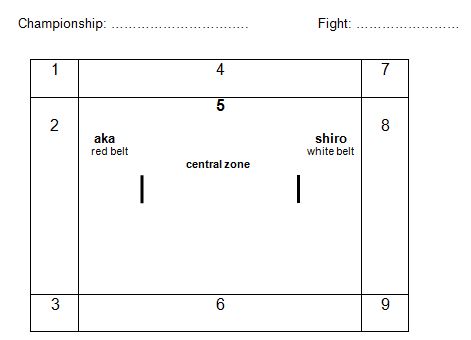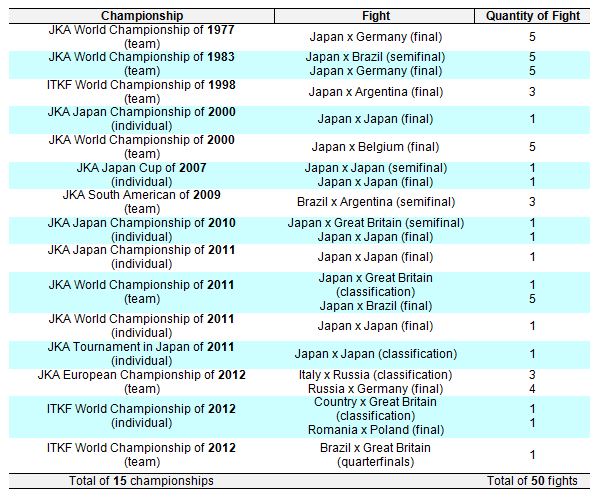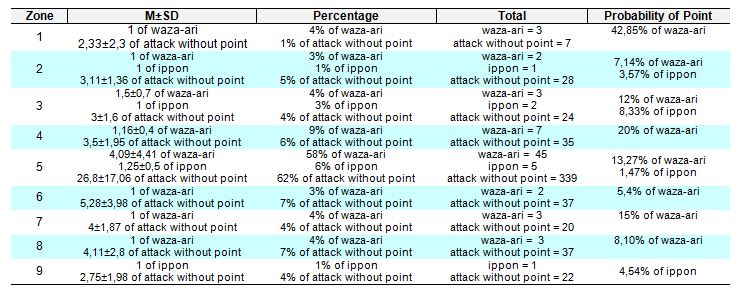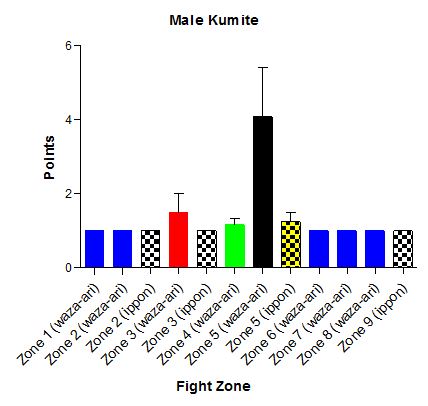
|
|||
|---|---|---|---|
|
|
Fight zone with points of the shotokan karate male competition La zona de combate con puntos de la competición masculina de karate shotokan |
|
|
|
Mestre em Ciência da Motricidade Humana pela UCB, RJ (Brasil) |
Nelson Kautzner Marques Junior |
|
|
|
Resumo Shotokan karate during the kumite (fight) competition occurs in a zone of 8x8 meters with a time of fight of 1 minute and 30 seconds to 2 minutes. The offensive techniques during the kumite are with light contact on the trunk of the karateka. After of the offensive technique of a karateka, the referee stops fight and determines the point attack or if there is no score in the attack. The point of the shotokan karate has the following characteristic: ippon is a perfect attack that is equals the one point, the fight ends. Waza-ari is an efficient attack that is equals the half point, a second waza-ari is an ippon, the fight ends. The objective of the study was to determine the fight zone with point during the male kumite of competition. This study used a quantitative research for identify the fight zone with point (ippon or waza-ari) or not during the male kumite of competition. Were selected on the Internet several championship of kumite of the JKA and of the ITKF. Kruskal-Wallis ANOVA verified significant difference between the fight zone with points, H (11) = 27,5 p = 0,003. The Mann Whitney U test detected significant difference between the zone 5 with waza-ari versus all the zone. In conclusion, the zone 5 was the fight zone with more points during the kumite because the shotokan karate has a fight of short duration, is the area where the fight starts and is a greater fight zone. Keywords: Karate. Sport. Fight. Fight zone.
|
|||
|
|
EFDeportes.com, Revista Digital. Buenos Aires - Año 18 - Nº 180 - Mayo de 2013. http://www.efdeportes.com/ |
|
|
1 / 1
Introduction
The analysis of the sports with high tactical component is important for the coach elaborates the training and orients the athlete1. The study about tactical of the indoor soccer determined that in the central zone near the goal occurred more goals2. In beach volleyball, male players practiced more spike in the zone 2, in the left side of the net3. In soccer, the corner kicks in the World Cup 2002, during the first time the zone of the area with more corner kicks was the small area4. Therefore, the study about tactical analysis of the competition zone is interesting for the coach knows the attack and the defense of a sport5, this permits better prepare the strategy and the tactical for the athlete during the competition6. Then, a study about the fight zone of the shotokan karate competition with point (ippon or waza-ari) is relevant for this sport.
Shotokan karate during the kumite (fight) competition occurs in a zone of 8x8 meters (m) with a time of fight of 1 minute and 30 seconds to 2 minutes. The literature of the shotokan karate detected that in the fight of competition the points are results of punches and kicks (ippon or waza-ari)7. The punches of the kumite with higher index score are the gyaku zuki, the kizami zuki and the oi zuki8. The kicks with more points in karate fight are the mae geri and the mawashi geri.
Doria et alii9 informed that the kumite has 50 to 74% of aerobic energy, 12 to 22% of anaerobic lactic energy and 14 to 28% of anaerobic alactic energy. The karateka in the fight practices tactical action with objective of study the opponent for perform the attack, in this action the aerobic metabolism predominates10. The karateka practices the attack action in the fight in few seconds with use of the rapid strength and of the anaerobic metabolism11. The offensive techniques during the kumite are with light contact on the trunk of the karateka12. After of the offensive technique of a karateka, the referee stops fight and determines the point attack or if there is no score in the attack13. The point of the shotokan karate has the following characteristic: ippon is a perfect attack that is equals the one point, the fight ends. Waza-ari is an efficient attack that is equals the half point, a second waza-ari is an ippon, the fight ends.
However, have few studies about the fight zone with point during the kumite in the literature this sport14,15. Then, a study about this theme is important. The objective of the study was to determine the fight zone with point during the male kumite of competition.
Methods
Subjects and procedures
This study used a quantitative research for identify the fight zone with point (ippon or waza-ari) or not during the male kumite of competition. Several championships of kumite of the JKA (Japan Karate Association) and of the ITKF (International Traditional Karate Federation) were selected in the Internet. The key words used to select the fighting were as follows: JKA kumite, ITKF kumite, JKA kumite team, ITKF kumite team, JKA Japan Championship, JKA World Championship and ITKF World Championship.
The data were collected by researcher of the Compaq® notebook, model Presario CQ43-325BR. In notebook, the researcher used a scout adapted from Oslin, Mitchell and Griffin16 to annotate in the fight zone of the attack with point (waza-ari or ippon) or not. When the researcher had doubt of the point or not in fight zone, he saw the attack again and wrote in the scout. The kumite competition occurs in a zone of 8x8 m, for more accuracy to annotate in the scout the researcher determined that the central zone has 6x6 m (zone 5). The lateral zone was divided with the following sizes: zone 2, zone 4, zone 6 and zone 8 have a length of 6 m by 1 m of wide. While that the zone 1, zone 3, zone 7 and zone 9 have 1x1 m. The scout is presented for the reader in figure 1.

Figure 1. Scout of the fight zone
To test the reliability, a second observation and annotation in the fight zone of the attack with point or not occurred after of 15 day by the same researcher17. After of quantifying the data, they were applied in the following equation18: Number of Agreements = [number of agreements: (number of agreements + number of disagreements)] . 100 = ?% of agreements.
The fighting used in the study is shown in table 1.
Table 1. Fights of the male kumite

Data analysis
Results are expressed as means ± standard deviations of the championship, percentage and total. The normality of data was assessed by the Shapiro Wilk test (p≤0,05). In case of data normal, the difference between the fight zones with points of the championship kumite were analyzed using an One-Way ANOVA with results accepted a level of significance of p≤0,05. Where a significant difference was found, a Scheffe post hoc test was used with results accepted a level of significance of p≤0,05. When the results have significant difference the research calculated the effect size (ES) in accordance with Dancey and Reidy19 (ES = [Mean – Mean]: Mean of the Standard Deviation) to the following classification: equal or greater than 0,8 is great, 0,5 to 0,7 is medium and 0,4 or less is small. In case of data not normal, the difference between the fight zones with points of the championship kumite was analyzed using a Kruskal-Wallis ANOVA H test with results accepted a level of significance of p≤0,05. Where a significant difference was found, the Mann-Whitney U test was used as post hoc with results accepted a level of significance of p≤0,05. When the results have significant difference the research calculated the ES in accordance with Dancey and Reidy19 (ES = [Mean – Mean]: Mean of the Standard Deviation) to the following classification: equal or greater than 0,8 is great, 0,5 to 0,7 is medium and 0,4 or less is small. Some data (Shapiro Wilk test, means ± standard deviations, One-Way ANOVA and Scheffe post hoc or Kruskal-Wallis ANOVA H test and Mann-Whitney U test) were calculated according to the procedures of the GraphPad Prism, version 5.0. Based in Weinberg and Goldberg20, was calculated the probability of points in the fight zone of the shotokan karate male competition with the following equation: Probability of Point = [number of points (ippon or waza-ari) in the fight zone: total of attack in the fight zone] . 100 = ?%.
Results and discussion
The reliability of the observation determined a percentage of agreements of 100% for waza-ari and for the ippon. The total of attack without point was of 544, the agreements of the attack without point was of 509, the disagreements of the attack without point was of 35 and the percentage of agreements was of 93,56%. The results obtained are above of the limit stipulated because Mesquita and Teixeira21 informed that a good reliability has values equal or greater than 80%. The Table 2 presents the descriptive statistics of the fight zone.
Table 2. Fight zone with point or not during the male kumite

Shapiro Wilk test determined data not normal. Kruskal-Wallis ANOVA verified significant difference between the fight zone with points, H (11) = 27,5 p = 0,003.
The Mann Whitney U test detected significant difference between the zone 5 with waza-ari versus all the zone, the results were the as follows: zone 5 with waza-ari x zone 3 with waza-ari, U = 3, p = 0,03, effect size = 1,01 great; zone 5 with waza-ari x zone 4 with waza-ari, U = 5, p = 0,004, effect size = 1,22 great; zone 5 with waza-ari x zone 5 with ippon, U = 4, p = 0,01, effect size = 1,15 great and zone 5 with waza-ari x others zones (zone 1 with waza-ari, zone 2 with waza-ari, zone 2 with ippon, zone 3 with ippon, zone 6 with waza-ari, zone 7 with waza-ari, zone 8 with waza-ari and zone 9 with ippon), U = 1,5, p = 0,01, effect size = 1,4 great. The others comparisons Mann Whitney U test detected no significant difference (p>0,05).
The figure 2 illustrates the mean and the standard deviations of the fight zone with points.

Figure 2. Fight zone with points during the male kumite
Zone 5 with waza-ari was the fight zone with more points during the male kumite (4,09 ± 4,41 of waza-ari). This result was identical to of Koropavanovski and Jovanovic15, central zone occur more points and lateral zone occur less points. Ajamil et alii14 also found more points in the central zone. The zone 5 or the central zone occur more points because 80% of the karate fights ending in less than 50 hundredths and 20% of the karate fight ending between 50 hundredths to 1 second and 30 hundredths22. The karate fight has a short duration and the zone 5 is the area where the fight starts, therefore this is a cause of more points in zone 5.
In the lateral zones occurs less point due to the short duration of the fight23 and the smaller size of these zones15. However, in the lateral zone, precisely the zone 1 was the region with more probability of points that this study found, 42,85% of waza-ari. The zone 1 has 1x1 m, a small space for karateka defend the opponent`s attack or practices other action of defense, for example, anticipate the opponent`s attack24. However, the zones 3, 7, and 9 have the same size and had less probability of points. What causes it? The references of the karate did not have information11,25.
In all lateral zones the karateka had the probability of 0,12% of practices a point. But the central zone (zone 5), during the combat, the karateka had the probability of 14,74% of practices a point. Franchini and Del Vecchio26 informed that combat sports the tactics is important during the fight. Therefore, the coach can teach the karateka for use more the lateral zone because in this zone causes less point. This action can be used when the fighter is winning kumite, the karateka should use lateral zone with the objective of have less opportunity of receiving an attack and allow that the time of the fight finishes.
Conclusion
The zone 5 was the fight zone with more points during the kumite because the shotokan karate has a fight of short duration, is the zone where the fight starts and is a greater fight zone. However, more studies should be done to confirm these findings.
References
-
Garganta J (2001). The performance analysis in sports games. Review on the game analysis. Rev Port Cien Desp 1(1):57-64. (In Portuguese)
-
Vilhena Silva M, Moreira M, Costa F, Greco P (2005). Comparison between the offensive actions of the final stage of the mineiro championship of indoor soccer in the pre mirim and mirim categories. FIEP 75 (special):284-287.
-
Chinchilla-Mira J, Pérez-Turpin J, Martínez-Carbonell A, Jove-Tossi M (2012). Offensive zones in beach volleyball: differences by gender. J Hum Sport Exerc 7(3):727-732.
-
Borrás D, Branda P (2005). Analysis of the corner kicks in the World Cup Korea and Japan 2002. Cult Ci Desp 2(1):83-93. (In Spanish)
-
Marques Junior N (2013). Scientific evidence about the volleyball skills: importance of this content to prescribing the training. Rev Bras Prescrição Fisiol Exerc 7(37):78-97. (In Portuguese)
-
Garganta J (2009). Trends of tactical performance analysis in team sports: bridging the gap between research, training and competition. Rev Port Cien Desp 9(1):81-89.
-
Sertic H, Segedi I, Vidranski T (2012). Situational efficiency arm and leg techniques in a karate fight of top-level female karate competitors. J Martial Arts Anthropol. 12(2):44-49.
-
Marques Junior N (2012). Shotokan karate: scores of the techniques during the female kumite of competition. Lecturas: Educ Fís Deportes 17(174):1-8. http://www.efdeportes.com/efd174/shotokan-karate-score-of-the-techniques.htm
-
Doria C, Veicsteines A, Limonta E, Maggioni M, Aschieri P, Eusebi F, Fanò G, Pietrangelo T (2009). Energetics of karate (kata and kumite techniques) in top-level athletes. Eur J Appl Physiol 107(5):603-610.
-
Marques Junior N (2012). Effort during the shotokan karate kumite in 13th Brazilian championship JKA, 2012. Lecturas: Educ. Fís. Deportes 17(172):1-10. http://www.efdeportes.com/efd172/effort-during-the-shotokan-karate-kumite.htm
-
Chaabène H, Hachana Y, Franchine E, Mkaouer B, Chamari K (2012). Physical and physiological profile of elite karate athletes. Sports Med 42(10):829-843.
-
Iide K, Imamura H, Yoshimura Y, Yamashita A, Miyahara K, Miyamoto N, Moriwaki C (2008). Physiological responses of simulated karate sparring matches in young men and boys. J Strength Cond Res 22(3):839-844.
-
Marques Junior N (2012). Scores of the techniques during the male kumite competition of the shotokan karate. Lecturas: Educ Fís Deportes 17(169):1-7. http://www.efdeportes.com/efd/.htm (In Portuguese)
-
Ajamil D, Moro R, Idiakez J, Jiménez M, Echevarría B (2011). Comparative study of combat actions in youth and adult karate classes. Apunts Educ Fís Deportes (104):66-79. (In Spanish)
-
Koropavanovski N, Jovanovic S (2007). Model characteristics of combat at elite male karate competitors. Serbian J Sports Sci 1(3):97-115.
-
Oslin J, Mitchell S, Griffin L (1998). The game performance assessment instrument (GPAI): development and preliminary validation. J Teach Phys Educ 17(-):231-243.
-
Mesquita I, Teixeira J (2004). The spike, attack zones and the opposing block in elite male beach volleyball. Int J Volleyball Res 7(1):57-62.
-
Marques Junior N, Nunes W, Tubino M, Silva V (2012). The effect of the peripheral vision training on the attack of beginner of the indoor soccer: an analysis about the studies of a dissertation. Lecturas: Educ Fís Deportes 17(171):1-20. http://www.efdeportes.com/efd171/visao-periferica-de-iniciados-do-futsal.htm (In Portuguese)
-
Dancey C, Reidy J (2006). Statistics without math for psychology. 3th ed. Porto Alegre: Artmed. (In Portuguese).
-
Weinberg S, Goldberg K (1990). Statistics for behavioral sciences. Cambridge: Cambridge University. p. 158-160.
-
Mesquita I, Teixeira J (2004). Attack is the strong attack (spike); we verified significant associations between type of attack and efficiency, between ranking classification and type of attack and between game moment and type of attack. Rev Bras Ci Esp 26(1):33-49. (In Portuguese)
-
Bessa L (2009). Simple reaction time and movement time of karate. 98 p. Faculty of Sport, University of Porto. (In Portuguese)
-
Sterkowicz-Przybycien K (2010). Body composition and somatotype of the top of polish male karate contestants. Biol Sport 27(3):195-201.
-
Nakayma M (2012). Best karate 3 – kumite. 7th ed. São Paulo: Cultrix. (In Portuguese)
-
Benedini S, Longo S, Caumo A, Luzi L, Invernizzi P (2012). Metabolic and hormonal responses to a single session of kumite and kata in karate athletes. Sports Sci Health 8(2-3):81-85.
-
Franchini E, Del Vecchio F (2011). Studies in combat sports: state of the art. Rev Bras Educ Fís Esporte. 25(special):67-81. (In Portuguese)
Another articles in English
 |

Búsqueda personalizada
|
|---|---|
|
EFDeportes.com, Revista Digital · Año 18 · N° 180 | Buenos Aires,
Mayo de 2013 |
|